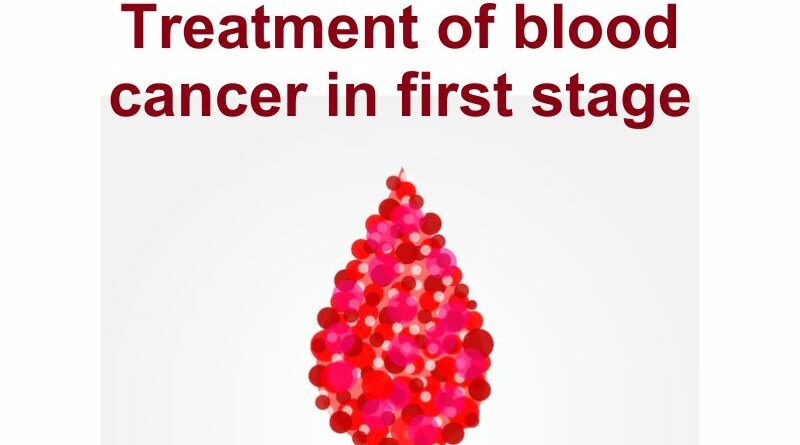Treatment of blood cancer in first stage
Blood cancer, also referred to as hematologic cancer, involves the abnormal growth of blood cells. The main types of blood cancer are leukemia, lymphoma, and myeloma. These cancers affect the bone marrow, lymphatic system, and blood cells, including white blood cells, red blood cells, and platelets. Blood cancers are often classified according to their stage, type, and the specific cells that are affected. The first stage of blood cancer, typically known as the early stage, is crucial for treatment because it can determine the success of the overall therapeutic approach.
In the first stage of blood cancer, the disease has just begun to develop. The cancer cells are usually present in small quantities and have not yet spread extensively to other parts of the body. Early detection is key, as treatment can often lead to a better prognosis and sometimes even remission if appropriately managed. This article explores the various treatment options available for blood cancer in its first stage.
1. Diagnosis of Blood Cancer
Before delving into the treatment options, it is important to understand the diagnostic process of blood cancer. Early detection plays a pivotal role in the effectiveness of treatment.
Doctors usually suspect blood cancer based on symptoms such as unexplained weight loss, fatigue, persistent fever, abnormal bruising or bleeding, swollen lymph nodes, or frequent infections. If blood cancer is suspected, several diagnostic tests are performed, including:
- Blood Tests: A complete blood count (CBC) can reveal abnormal numbers of blood cells, which may indicate leukemia or other types of blood cancers.
- Bone Marrow Biopsy: A sample of bone marrow is taken to examine the cells and confirm the diagnosis.
- Imaging Tests: CT scans or PET scans may be used to check for tumors or lymph node enlargement.
Once a diagnosis is made, the cancer is staged to determine the extent of its progression. In the first stage, the cancer is confined to one part of the body, and treatment options are more effective as the disease has not yet spread widely.
2. Treatment Options for Blood Cancer in the First Stage
The treatment for blood cancer in its first stage primarily depends on the type of cancer (leukemia, lymphoma, or myeloma), the patient’s general health, age, and the specific characteristics of the cancer. Treatment can vary widely, ranging from chemotherapy to targeted therapies or stem cell transplants. The aim is to eradicate the cancer or achieve long-term remission while minimizing side effects.
A. Chemotherapy
Chemotherapy is one of the most common treatments for blood cancers, including leukemia and lymphoma. It involves the use of powerful drugs to kill cancer cells or stop their growth. Chemotherapy can be administered orally, intravenously, or directly into the cerebrospinal fluid, depending on the cancer’s type and location.
- Leukemia: In leukemia, chemotherapy is often the first-line treatment. Since leukemia affects blood cells, chemotherapy is used to target the rapidly dividing cancerous cells in the blood and bone marrow. In early-stage leukemia, chemotherapy may involve a combination of drugs to induce remission and reduce the number of abnormal blood cells.
- Lymphoma: For Hodgkin’s and non-Hodgkin’s lymphoma, chemotherapy can help shrink tumors and stop the cancer cells from spreading. Chemotherapy for lymphoma is often combined with radiation therapy, especially in the first stage of the disease.
Chemotherapy is effective in many cases, but it can also have side effects such as hair loss, nausea, fatigue, and an increased risk of infections, as it suppresses the immune system.
B. Radiation Therapy
Radiation therapy is commonly used for blood cancers such as lymphoma. In the early stages of lymphoma, radiation can be used to target specific areas where cancerous cells are concentrated, such as swollen lymph nodes or tumors. The goal is to destroy cancer cells while minimizing damage to healthy tissues surrounding the tumor. Radiation therapy is often used in conjunction with chemotherapy to enhance treatment effectiveness.
- Hodgkin’s Lymphoma: Early-stage Hodgkin’s lymphoma may respond well to radiation therapy alone, but combination treatment with chemotherapy is also common.
- Non-Hodgkin’s Lymphoma: The treatment of non-Hodgkin’s lymphoma often involves a combination of chemotherapy and radiation therapy to address different aspects of the cancer.
C. Targeted Therapy
Targeted therapies are newer treatments that focus on specific molecules involved in the growth of cancer cells. They are less damaging to healthy cells compared to chemotherapy and radiation, and they are used in the first stage of blood cancer, particularly in cancers with specific genetic mutations.
- Chronic Myelogenous Leukemia (CML): In CML, targeted therapies such as tyrosine kinase inhibitors (TKIs) can block the signals that promote cancer cell growth. Imatinib (Gleevec) is one of the most well-known drugs used in the treatment of CML.
- Lymphoma: Targeted therapy can be used for some types of lymphoma, especially when the cancer cells have specific mutations or markers. For example, Rituximab (Rituxan) targets CD20 proteins on the surface of B-cells and is often used in the treatment of non-Hodgkin’s lymphoma.
Targeted therapies can significantly improve survival rates and have fewer side effects compared to traditional chemotherapy, making them ideal for early-stage blood cancers.
D. Immunotherapy
Immunotherapy is a type of treatment that boosts the body’s natural immune system to fight cancer. This therapy can be especially effective for blood cancers like leukemia, lymphoma, and myeloma.
- Checkpoint Inhibitors: In cases of Hodgkin’s lymphoma, checkpoint inhibitors such as pembrolizumab (Keytruda) are used to help the immune system recognize and destroy cancer cells.
- CAR T-cell Therapy: For certain types of blood cancers, chimeric antigen receptor (CAR) T-cell therapy may be used, which involves modifying the patient’s own immune cells to better attack cancer cells. This therapy is more commonly used in later stages but is being explored in earlier stages as well.
Immunotherapy can be a promising option for patients with blood cancers, especially those who do not respond well to chemotherapy or radiation.
E. Stem Cell Transplantation
In some cases of blood cancer, especially in leukemia and myeloma, stem cell transplantation (also known as bone marrow transplantation) may be an option in the first stage, depending on the patient’s specific condition. In this procedure, damaged or diseased bone marrow is replaced with healthy stem cells from a donor or the patient’s own cells (autologous transplant).
Stem cell transplants are typically considered for more aggressive or recurrent cancers, but in some cases of first-stage cancer, they can be a potential cure if the disease has a high likelihood of relapsing.
3. Personalized Treatment Approaches
Personalized medicine is an emerging approach in the treatment of blood cancer, which tailors treatment based on the genetic makeup of the cancer cells and the individual patient. By analyzing genetic mutations, doctors can better understand which treatments are most likely to be effective and avoid unnecessary side effects.
This approach is especially important for blood cancers like leukemia and lymphoma, where the molecular characteristics of the disease can vary significantly. The first stage of treatment is often guided by these genetic insights, leading to more effective and targeted therapies.
4. Monitoring and Follow-up
After the initial treatment, regular follow-up visits are critical for monitoring the patient’s progress. This includes blood tests, imaging, and bone marrow biopsies to check for signs of remission or recurrence. In many cases, the treatment for blood cancer in the first stage aims to bring about remission, meaning that cancer cells are no longer detectable in the body.
For patients with a positive response to treatment, the next phase involves continued monitoring to ensure the cancer does not relapse. In some cases, additional treatments such as maintenance therapy may be required to reduce the risk of recurrence.
Conclusion
The treatment of blood cancer in its first stage is highly effective, especially when the disease is detected early. The primary treatment modalities include chemotherapy, radiation therapy, targeted therapy, immunotherapy, and stem cell transplantation. Each of these therapies has its strengths, and the best treatment plan is often a combination of these methods. Personalized medicine is becoming an increasingly important aspect of treatment, offering more tailored and effective approaches.
With advances in treatment options and early detection, many people with first-stage blood cancer can achieve long-term remission and live healthy lives. However, the treatment journey is complex and requires careful monitoring and ongoing care from healthcare professionals to ensure the best possible outcomes.
Read more – (Click here)




